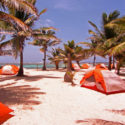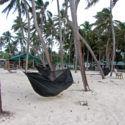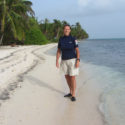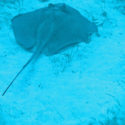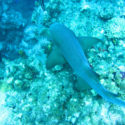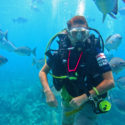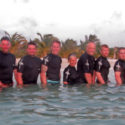Personnel were from across the RNRM service, including: CTCRM, 30 Cdo RM, HM Surface Ships, HM Submarines and the Fleet Air Arm.
From 2 – 17 July 16 Commando Training Centre Royal Marines led Adventurous Training (AT) in three phases on the mainland and cayes of Belize. The aim of phase 1 and 3 was continuation Sub-Aqua diver training to allow participants to gain further AT experience in a remote adventurous location, being completely self-sufficient, whilst conducting depth progression diving down to 50m for suitably qualified divers on some of the most pristine and remote reefs systems in the Caribbean. Phase 2, after the first diving phase, was a mainland based cultural period to appreciate what else Belize has to offer. The Expedition bought together a whole naval service group, ranks ranging from Lt Cdr – Marine, including one Naval Reservist, me.
It took two days of travelling from 30 Cdo RM, Plymouth, to get to the British Army Training Support Unit Belize (BATSUB), where we collected stores and kit for life on the islands. We then travelled by boat through the maze of reefs, to our first island, South West Caye on Glover’s reef. We took everything with us to be totally self-sufficient including food, water, fuel, and a compressor. There was a lot of lifting and shifting required. The island was a tropical paradise with white sand, palm trees, turquoise sea, and that’s where we set up our one-man tents. Ablutions were a combination of compostable toilets and an open air rainwater solar shower – we had been warned island life would be basic.
The first few days diving ensured basic skills were covered, along with BSAC Rescue drills being introduced to the PADI qualified divers. This opportunity was also used to assess divers in water ability with DSMB and SMB practice while, on some of the most spectacular reefs in the world alongside sea life, including dolphins and rays. On our fourth day we went for a day-visit to Long Caye Island, a pretty Eco Resort, and the place to start progressing our depth. Here the group encountered a large number of nurse sharks, turtle and some very friendly Remora, which seemed to think the divers were as good as anything to stick to.
Once back on dry land we went to Bocawina Rain Forest Camp. We did a night walk through the jungle, tracking fresh jaguar prints and meeting a large tarantula. After a good night’s sleep in a real bed we embarked on a trek into the jungle stopping at the top of a waterfall for a dip in the natural pools, and to look at some outstanding views over the forest, then zip lining in the afternoon though the canopy. The following day we travelled to the Actun Tunichil Muknal caves where we had to swim and climb through the cave system to see a Mayan archaeological site.
We then embarked on our second diving phase and travelled out to Half Moon Caye on Lighthouse Reef. After some issues with our cylinders overheating and losing air, we continued our dive progression to 40m. Our night on this remote island was spent charging cylinders, cooking a simple BBQ, and sleeping in hammocks hung between the palm trees. We were then set for the main event of the exped, the Great Blue Hole of Belize. We arrived early with only two small boats before us. The Hole was very dark and we kept the side wall in sight on our descent, going past the caves at 42m, watching our computers to reach 50m. As we started our slow ascent, we were circled by large reef and bull sharks which disappeared back into the blue when we reached 30m. After everyone had been in the Blue Hole, we went back to the mainland, with one last stop for a shallow dive on a site aptly named The Aquarium where we were effectively mugged by a shoal of fish.
Back at BATSUB we returned all the diving kit and stores, and made our way out to Caye Caulker for a day, followed by a visit to San Pedro for a cultural visit and to off-gas before the long journey back to the UK.
Belize gave us the opportunity for thrilling and challenging diving from isolated atolls, while proving our ability to operate in a far-flung exciting locations totally autonomously, and having the chance to depth progress down to 50m in the Blue Hole which was definitely a once in a life time experience.
Lynn Reed, PO(RNR)

